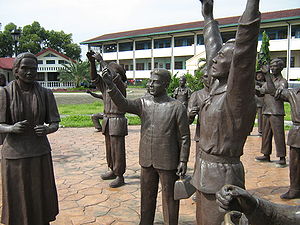Philippine News
‘Cry of Pugad Lawin’ in 1896: A showcase of the freedom-loving nature of the Filipino people
MANILA — The “Cry of Pugad Lawin” raised by the Katipuneros against the tyrannous Spanish rule in the Philippines in 1896 showcased not just the bravery and courage of the Filipino people but also their freedom-loving trait and nature.
The historic “Cry” referred to the event wherein Andres Bonifacio and his poorly-armed men gathered near the house of the Grand Old Lady of the Katipunan — Melchora Aquino, better known as Tandang Sora — at Pugad Lawin and declared themselves and all the people of the islands as free and sovereign nation by tearing their “cedula” (residence certificate) on Aug. 23, 1896.
“Their courage to tear their cedula was a symbol of their courage and refusal to be oppressed by Spain,” said 84-year-old Natividad M. Villano, a descendant of one of the Katipunero leaders in the former town of Novaliches, now divided between Quezon City and Caloocan City.
The place Pugad Lawin is now a part of the 75-year-old Quezon City, along with equally historic Pasong Tamo, Banlat, Balintawak, Pasong Putik, and Kangkong, now renamed as Barangay Apolonio Samson.
History books, however, show that at the time of the 1896 Revolution, these places were parts of Novaliches, one of the towns comprising the then province of Manila. It was then a neighbor of Marikina, Montalban, Caloocan, Polo, Meycauayan, Marilao and San Jose del Monte, Bulacan.
Pasong Tamo was where the very first encounter between the Katipuneros and the Spanish soldiers took place on Aug. 26, 1896, while Banlat was the birthplace of Tandang Sora on Jan. 6, 1812.
On the other hand, Balintawak was said to be the place where Bonifacio and his men first unfurled his revolutionary flag, while Kangkong was the residence of the Revolutionary Gen. Apolonio Samson, where the Katipuneros often held their secret meetings.
It was in Pasong Putik, present-day Lagro and home to the La Mesa Dam, where Tandang Sora was arrested by the Spaniards before she was incarcerated at the Bilibid Prisons in Manila and eventually exiled to Guam.
The town of Novaliches was first annexed to Caloocan municipality during the American occupation of the Philippines in 1901, and divided in 1948 between Quezon City and Caloocan, which also became a city in 1962.
Though Bonifacio was a native of Manila, he often went to Novaliches, where he had two close friends — Tomas Geronimo and Canuto Dumalay — when he was in the process of organizing the Katipunan. Geronimo and Dumalay are now remembered with a street each in the former Novaliches Poblacion or town center.
Another reason Bonifacio often passed by Novaliches while he was recruiting membership into the Katipunan was that he had many relatives in Novaliches and the then neighboring town of Polo, Bulacan.
Polo was the hometown of his close friend and associate in the Katipunan, Dr. Pio Valenzuela. Polo was later renamed Valenzuela town and was eventually converted into a city in the second half of the 1990s.
Despite its erasure from the country’s map, Novaliches today continues to play a significant role in history. One factual indication of this is that a more than 150-year-old duhat tree (blackberry tree) situated in the once hilly portion of Barangay Kaligayahan was declared in 1980 as “Katipunan Tree,” the only of its kind in the entire country. The place where it stands at the compound of the Metro Manila College (MMC), formerly Novaliches Academy, is now called “Dambana ng Katipunan” or Katipunan Shrine.
According to testimonies of some former members of the Katipunan from Novaliches when they were still alive, it was under the shade of that tree where Bonifacio and his men took refuge and rest after their frequent encounters with the Spaniards.
“It was also in this place where they conducted frequent meetings. The heroine Melchora Aquino usually treated and fed many of the wounded Katipuneros here,” Mrs. Villano said as she recalled her father’s narration to them about his experiences during the Spanish period.
According to Efren Figueroa, a fourth generation descendant of Melchora Aquino, the heroine was born in Banlat or Gulod ng Banilad, now named as Barangay Tandang Sora in Quezon City.
“It is elating to be recognized that she (referring to Tandang Sora) came from what is now part of QC which shows that we have a blood of courage to support a quest for freedom, unselfishness and generosity,” said Figueroa in an interview with the Philippines News Agency.
He added that it is a great pride and honor to look back at history and say that they are descendants of someone who made a great contribution to the country and its people in the quest for freedom.
He also said that they feel proud that Tandang Sora, despite her old age at the time, thought less of herself but more for the welfare of the freedom-loving Filipinos whom she nourished and healed as her participation in the revolution.






















